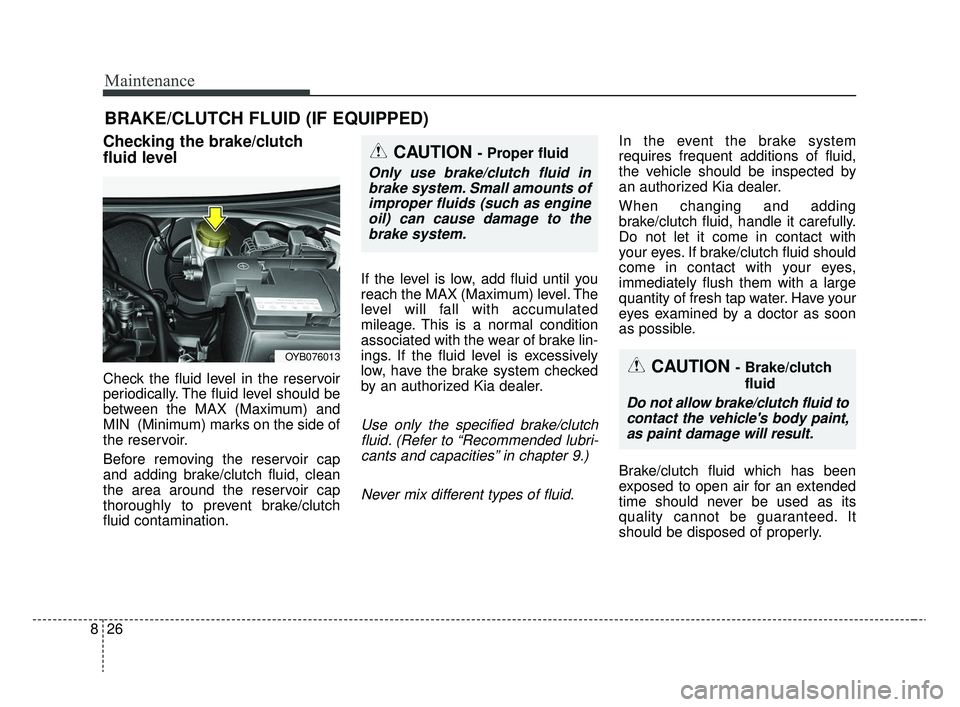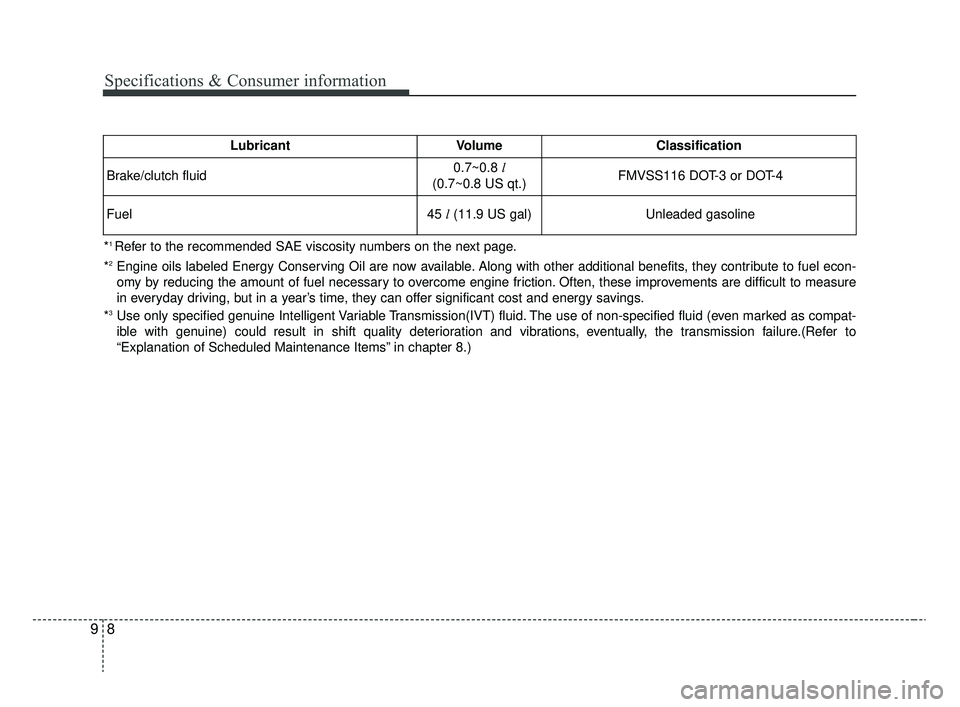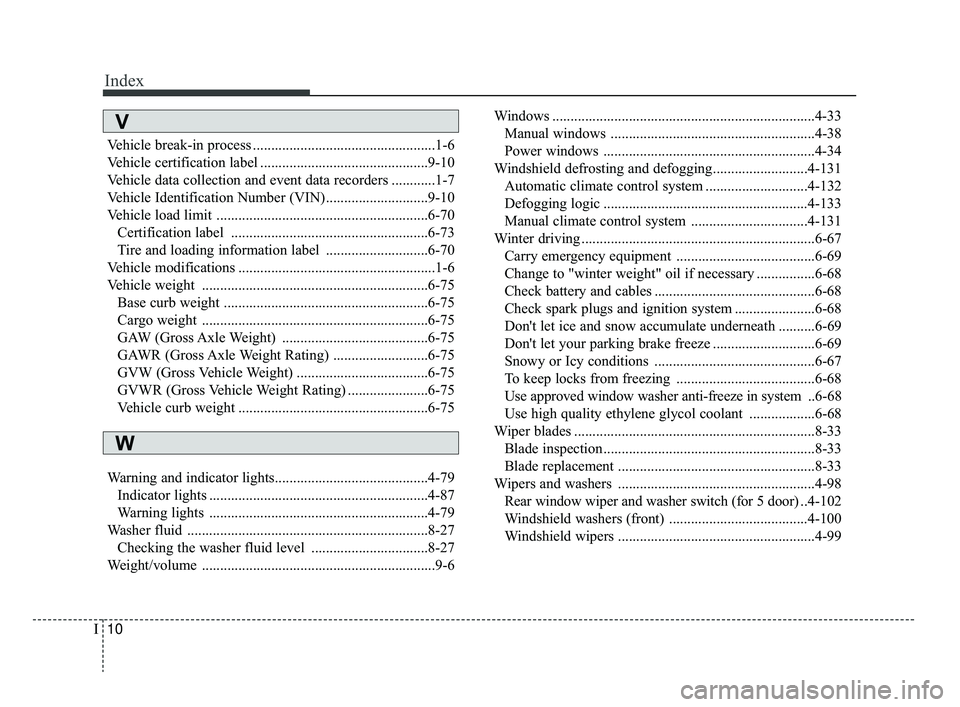2020 KIA RIO brake fluid
[x] Cancel search: brake fluidPage 403 of 516

Maintenance
20
8
CHECKING FLUID LEVELS
When checking engine oil, engine
coolant, brake fluid, and washer fluid,
always be sure to clean the area
around any filler plug, drain plug, or
dipstick before checking or draining
any lubricant or fluid. This is espe-
cially important in dusty or sandy
areas and when the vehicle is used
on unpaved roads. Cleaning the plug
and dipstick areas will prevent dirt
and grit from entering the engine and
other mechanisms that could be
damaged.
SC CAN (ENG) 8.qxp 6/7/2019 9:40 AM Page 20
Page 409 of 516

Maintenance
26
8
BRAKE/CLUTCH FLUID (IF EQUIPPED)
Checking the brake/clutch
fluid level
Check the fluid level in the reservoir
periodically. The fluid level should be
between the MAX (Maximum) and
MIN (Minimum) marks on the side of
the reservoir.
Before removing the reservoir cap
and adding brake/clutch fluid, clean
the area around the reservoir cap
thoroughly to prevent brake/clutch
fluid contamination. If the level is low, add fluid until you
reach the MAX (Maximum) level. The
level will fall with accumulated
mileage. This is a normal condition
associated with the wear of brake lin-
ings. If the fluid level is excessively
low, have the brake system checked
by an authorized Kia dealer.
Use only the specified brake/clutch
fluid. (Refer to “Recommended lubri-cants and capacities” in chapter 9.)
Never mix different types of fluid.
In the event the brake system
requires frequent additions of fluid,
the vehicle should be inspected by
an authorized Kia dealer.
When changing and adding
brake/clutch fluid, handle it carefully.
Do not let it come in contact with
your eyes. If brake/clutch fluid should
come in contact with your eyes,
immediately flush them with a large
quantity of fresh tap water. Have your
eyes examined by a doctor as soon
as possible.
Brake/clutch fluid which has been
exposed to open air for an extended
time should never be used as its
quality cannot be guaranteed. It
should be disposed of properly.
OYB076013CAUTION - Brake/clutch fluid
Do not allow brake/clutch fluid tocontact the vehicle's body paint,as paint damage will result.
CAUTION - Proper fluid
Only use brake/clutch fluid inbrake system. Small amounts ofimproper fluids (such as engineoil) can cause damage to thebrake system.
SC CAN (ENG) 8.qxp 6/7/2019 9:40 AM Page 26
Page 485 of 516

Maintenance
102
8
Underbody maintenance
Road salt and other corrosive chemi-
cals are used in cold weather states to
melt snow and prevent ice accumula-
tion. If these chemicals are not regu-
larly removed, they will corrode the
vehicle underbody and over time dam-
age fuel lines, the fuel tank retention
system, the vehicle suspension, the
exhaust system, and even the body
frame.
Wash the undercarriage of your
vehicle regularly during the winter
and whenever your vehicle has
been exposed to such salts or
chemicals.
Do a thorough washing of the undercarriage at the end of the
winter.
Use professional service techni- cians or governmental inspection
stations to annually inspect for cor-
rosion. Immediately seek an inspection of
your vehicle if you become visually
aware of corrosion flaking or scal-
ing or if you become aware of a
change in vehicle performance,
such as soft or spongey brakes,
fluids leaking, impairment of direc-
tional control, suspension noises
or rattling metal straps.
Aluminum wheel maintenance
The aluminum wheels are coated
with a clear protective finish.
Do not use any abrasive cleaner,polishing compound, solvent, or
wire brushes on aluminum wheels.
They may scratch the finish.
Clean the wheel when it has cooled.
Use only a mild soap or neutral detergent, and rinse thoroughly
with water. Also, be sure to clean
the wheels after driving on salted
roads. This helps prevent corro-
sion.
Avoid washing the wheels with highspeed vehicle wash brushes.
Do not use any alkaline or acid detergents as they may damage or
corrode aluminum wheels coated
with a clear protective finish.
SC CAN (ENG) 8.qxp 6/7/2019 9:44 AM Page 102
Page 502 of 516

Specifications & Consumer information
89
*1 Refer to the recommended SAE viscosity numbers on the next page.
*
2Engine oils labeled Energy Conserving Oil are now available. Along with other additional benefits, they contribute to fuel econ-
omy by reducing the amount of fuel necessary to overcome engine friction. Often, these improvements are difficult to measure
in everyday driving, but in a year’s time, they can offer significant cost and energy savings.
*
3Use only specified genuine Intelligent Variable Transmission(IVT) fluid. The use of non-specified fluid (even marked as compat-
ible with genuine) could result in shift quality deterioration and vibrations, eventually, the transmission failure.(Refer to
“Explanation of Scheduled Maintenance Items” in chapter 8.)
LubricantVolumeClassification
Brake/clutch fluid0.7~0.8 l
(0.7~0.8 US qt.)FMVSS116 DOT-3 or DOT-4
Fuel45 l(11.9 US gal)Unleaded gasoline
SC CAN (ENG) 9.qxp 12/12/2019 5:07 PM Page 8
Page 509 of 516

I3
Index
Good braking practices ..............................................6-40
Hill-start Assist Control (HAC) ..................................6-37
Parking brake ..............................................................6-29
Power brakes ..............................................................6-27
Vehicle Stability Management (VSM)........................6-38
Brake/clutch fluid ..........................................................8-26 Checking the brake/clutch fluid level ........................8-26
Bulb wattage ....................................................................9-3
Checking fluid levels ....................................................8-20
Child Restraint System (CRS) ......................................3-28 Using a child restraint system ....................................3-29
Climate control air filter ................................................8-31 Filter inspection ..........................................................8-31
Cruise Control system ..................................................6-54 Cruise control switch ..................................................6-54
To cancel cruise control ..............................................6-57
To decrease the cruising speed ..................................6-56
To increase cruise control set speed ..........................6-56
To resume cruising speed at more than approximately 30 km/h (20 mph) ....................................................6-57
To set cruise control speed..........................................6-55
To temporarily accelerate with the cruise control on 6-56
To turn cruise control off ............................................6-58 Declaration of conformity ............................................5-42
IC ........................................................................\
........5-42
Defroster ......................................................................4-\
108 Rear window defroster ..............................................4-108
Dimensions ......................................................................9-\
2
Door locks......................................................................4-\
19 Auto door lock/unlock feature ....................................4-22
Child-protector rear door lock ....................................4-22
Impact sensing door unlock system ............................4-22
Operating door locks from inside the vehicle ............4-20
Operating door locks from outside the vehicle ..........4-19
Speed sensing door lock system ................................4-22
Economical operation ....................................................6-60
Emergency starting ..........................................................7-5 Jump starting ................................................................7-5
Push-starting ................................................................7-6
Emission control system ..............................................8-108 Crankcase emission control system ..........................8-108
Evaporative emission control (including ORVR: Onboard Refueling Vapor Recovery) system ........8-108
Exhaust emission control system ..............................8-109
Engine ........................................................................\
......9-2
Engine compartment ................................................2-7, 8-4
C
D
E
SC CAN (ENG) Index.qxp 12/12/2019 5:06 PM Page 3
Page 516 of 516

Index
10I
Vehicle break-in process ..................................................1-6
Vehicle certification label ..............................................9-10
Vehicle data collection and event data recorders ............1-7
Vehicle Identification Number (VIN)............................9-10
Vehicle load limit ..........................................................6-70Certification label ......................................................6-73
Tire and loading information label ............................6-70
Vehicle modifications ......................................................1-6
Vehicle weight ..............................................................6-75 Base curb weight ........................................................6-75
Cargo weight ..............................................................6-75
GAW (Gross Axle Weight) ........................................6-75
GAWR (Gross Axle Weight Rating) ..........................6-75
GVW (Gross Vehicle Weight) ....................................6-75
GVWR (Gross Vehicle Weight Rating) ......................6-75
Vehicle curb weight ....................................................6-75
Warning and indicator lights..........................................4-79 Indicator lights ............................................................4-87
Warning lights ............................................................4-79
Washer fluid ..................................................................8-27 Checking the washer fluid level ................................8-27
Weight/volume ................................................................9-6 Windows ........................................................................\
4-33
Manual windows ........................................................4-38
Power windows ..........................................................4-34
Windshield defrosting and defogging..........................4-131 Automatic climate control system ............................4-132
Defogging logic ........................................................4-133
Manual climate control system ................................4-131
Winter driving ................................................................6-67 Carry emergency equipment ......................................6-69
Change to "winter weight" oil if necessary ................6-68
Check battery and cables ............................................6-68
Check spark plugs and ignition system ......................6-68
Don't let ice and snow accumulate underneath ..........6-69
Don't let your parking brake freeze ............................6-69
Snowy or Icy conditions ............................................6-67
To keep locks from freezing ......................................6-68
Use approved window washer anti-freeze in system ..6-68
Use high quality ethylene glycol coolant ..................6-68
Wiper blades ..................................................................8-33 Blade inspection ..........................................................8-33
Blade replacement ......................................................8-33
Wipers and washers ......................................................4-98 Rear window wiper and washer switch (for 5 door) ..4-102
Windshield washers (front) ......................................4-100
Windshield wipers ......................................................4-99
W
V
SC CAN (ENG) Index.qxp 12/12/2019 5:06 PM Page 10